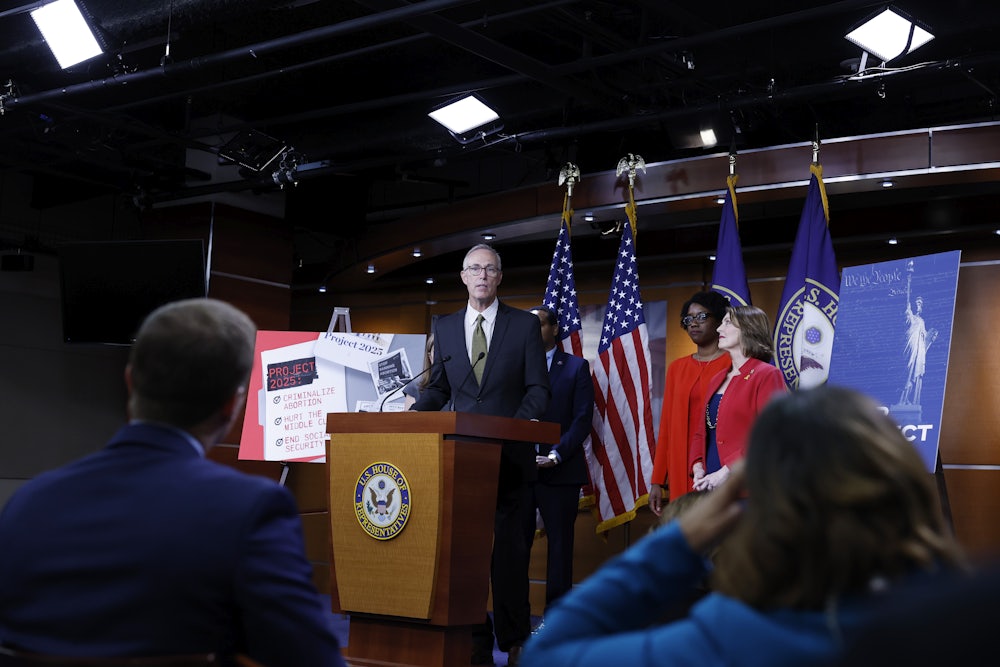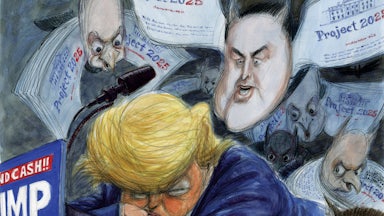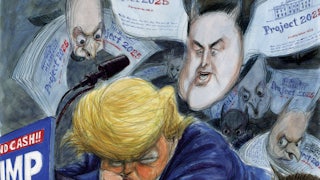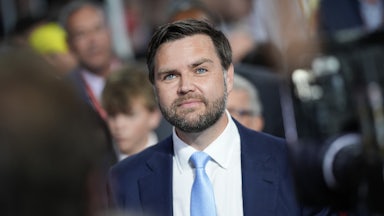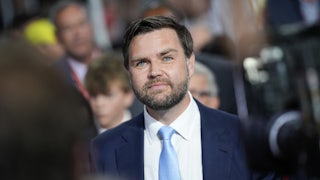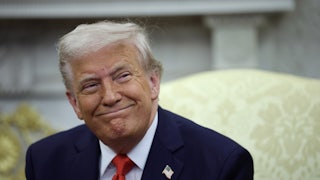Congressional Democrats spent Tuesday pressing Republicans on a slew of policies outlined by Project 2025—a 922-page proposal for a future GOP presidency, written in part by allies of former President Donald Trump—holding a mock hearing on Tuesday on some of the key planks in the agenda. Polling data shows that despite the fact that Trump has claimed plausible deniability and disavowed the document, Project 2025 has penetrated the public consciousness—and that it is unpopular with those Americans who have heard of the proposal. Democrats are trying to keep the project in the zeitgeist and, more importantly, at the top of the news cycle.
Tuesday’s presentation by House Democrats, organized by the Democratic Stop Project 2025 Task Force and the Democratic Policy and Steering Committee, had all the trappings of a formal hearing despite the absence of Republican members. It bore more than a passing resemblance to the hearings held by the House select committee that investigated the attack on the Capitol on January 6, 2021, featuring slickly produced videos and other multimedia elements. This was more than mere homage: As The Washington Post first reported, one of the filmmakers involved with the January 6 committee also worked on the videos for Tuesday’s presentation, which highlighted the connections between Trump, other Republicans, and the Project 2025 platform.
Several of the videos simply featured previous comments by Republicans, including Trump boasting about being responsible for the end of Roe, and Russell Vought—the co-author of Project 2025 and Trump’s former director of the Office of Management and Budget—saying on video that Trump had “blessed” his policy ideas.
Representative Dan Kildee, who participated in the event on Tuesday, said that he believed the purpose of these videos was “to show Trump and his allies saying these things in their own words.”
“In a similar fashion, you saw how the January 6 committee used Republican witnesses ... in their own words. It was very effective,” Kildee said.
Democrats have gone to great pains to connect Trump—and, by extension, all Republicans—to Project 2025. The Democratic National Committee has launched billboard campaigns across several states tying Trump to the policies outlined in its pages. Comedian Kenan Thompson skewered the proposal onstage at the Democratic National Committee, and late-night host John Oliver dedicated a segment of his show to explaining its key planks earlier this year. Harris mentioned Project 2025 explicitly in her debate with Trump. Downballot Democrats are tying their Republican opponents to the proposal in advertisements; on Capitol Hill, Democratic lawmakers are keeping focus on the issue with events like the presentation on Tuesday.
Project 2025 includes several red-meat promises for Republicans, including severe restrictions on abortion access, a purge of thousands of government employees, the elimination of the Department of Education, a reshaping of the Justice Department, the undoing of protections for LGBTQ individuals, and a rollback of efforts to combat climate change. Some of these priorities would require congressional cooperation, but others could be accomplished through executive action—such as revoking Food and Drug Administration approval for abortion medication.
Democrats endeavored to put human faces to what they saw as the most objectionable of Project 2025’s proposals. The presentation on Tuesday included testimony from a woman who needed to travel out of her home state of Wisconsin to obtain an abortion, an autoworker from Michigan who spoke about the agenda’s anti-union provisions, and a Virginia woman who relies on Medicare to obtain insulin. It focused specifically on abortion, the economy, and Social Security and Medicare access—topics that are among the most important for American voters.
But given the lack of bipartisan cooperation, the presentation could be seen more as a series of campaign talking points than a concrete call to action, focused as it was on what could happen if Republicans gain control of the White House and Congress. Similar previous efforts by the Stop Project 2025 Task Force, such as setting up a “tip line” to obtain more information about the agenda, have not had the full force of Congress behind them.
Trump has denied any connection to Project 2025, even as former Trump administration officials and allies helped to draft the proposal. The Washington Post also reported that in 2022, Trump took a private flight with the president of the Heritage Foundation, the organization behind Project 2025; Heritage Foundation president Kevin Roberts has said that he discussed Project 2025 with Trump, although he has also told Fox News that Trump had nothing to do with its crafting.
“I have nothing to do with Project 2025,” Trump said during the debate with Harris earlier this month. “I haven’t read it. I don’t want to read it purposely. I’m not going to read it.” However, several of Trump’s stated priorities and those outlined in Project 2025 intersect, such as mass deportation of undocumented immigrants, reshaping the federal civil service to be staffed by loyalists, and eliminating the Department of Education.
Congressional Republicans have also kept their distance from Project 2025, even as Democrats work to connect them to it. Although it was billed as a hearing, no Republicans participated in the event on Tuesday. But Democrats believe that Trump’s disavowal of the proposal should not be taken seriously. “Most people have seen enough from Donald Trump and his MAGA allies to know that these dots connect themselves,” said Representative Jared Huffman, the co-leader of the Stop Project 2025 Task Force, who has also introduced a resolution condemning the agenda.
Project 2025 seems to have embedded itself in the public consciousness in a manner that is perhaps unexpected for a 900-page policy brief. An NBC News poll released on Sunday found that 57 percent of voters have a negative view of Project 2025, as compared to 4 percent with a positive view. According to a September New York Times/Siena College poll, roughly 60 percent of likely voters had heard of Project 2025; of that number, 63 percent opposed the policies proposed by the plan. That same poll found that 71 percent of respondents who had heard of Project 2025 believed Trump would try to enact all or some of the policies outlined in the proposal.
Independent voters appear to dislike Project 2025 as well, with a September YouGov poll showing that 53 percent of independents have a negative view of it. Forty-eight percent of young voters, another critical demographic, feel unfavorably toward Project 2025, compared to only 6 percent with favorable views, according to the most recent Harvard Youth Poll.
An August poll from the University of Massachusetts at Amherst and YouGov highlighted the particular elements of Project 2025 that Americans oppose: 51 percent oppose reducing federal protections for lesbian, gay, and transgender individuals; 68 percent oppose firing federal employees and replacing them with loyalists to the president; 72 percent oppose restricting access to contraception; 64 percent oppose eliminating the Department of Education; and 56 percent oppose slashing investments in renewable energy.
Democrats’ desire to focus on the unpopular elements of Project 2025 is a counter to Republican messaging on the issues where voters prefer Trump. The recent NBC News poll found that voters believed Trump would be better on dealing with crime and violence, the economy, inflation and cost of living, and on securing the southern border. Although Harris has not exactly shied away from these issues—she has proposals on lessening the cost of housing and has decried Trump for opposing a bipartisan border security bill crafted in the Senate—they are proving to be persistent weak spots for her.
But rather than try to bolster those areas of weakness, the Democratic focus on Project 2025 could have the purpose of reminding voters of what they don’t like about Trump’s policy ideas. Democratic Senator Chris Murphy said that Project 2025 was a good target for Democrats because it was so all-encompassing.
“It’s not often that a party with a deeply unpopular agenda puts it all down in very lurid detail,” said Murphy. “For some people there is a disconnect between what Trump says and what they think he will do. And they’re making it clear that in Trump’s second term … all the most divisive stuff is going to happen, and happen quickly.”
* This story has been updated.
